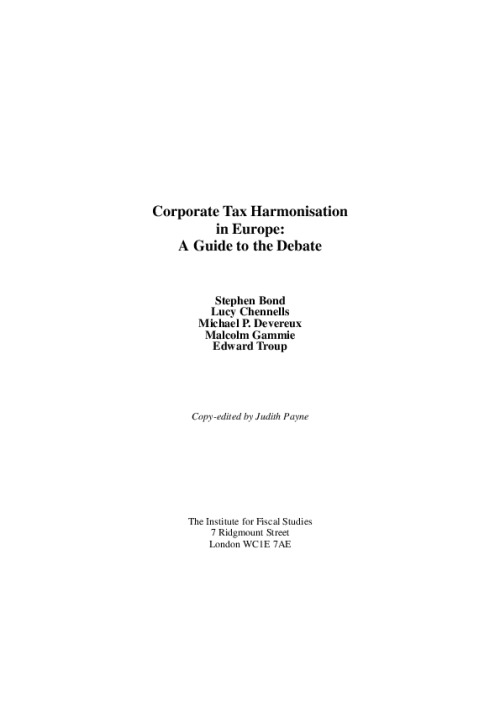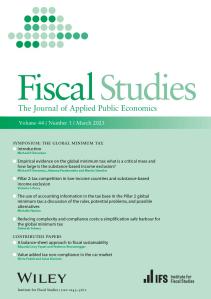Thus it is not surprising that proposals for greater co-ordination of corporate income taxes are back on the international policy agenda, notably through the development of the EU's Code of Conduct on business taxation. And whatever the outcome of these present policy initiatives, it is unlikely that this issue will go away. The aim of this report is therefore to shed some light on the complex issues that surround this debate. The European Commission's current interest in corporate tax harmonisation is prompted by a presumption that Ѩarmful' tax competition is resulting in a shift in taxation away from taxes on mobile capital and towards taxes on comparatively immobile labour, and by a concern that this development is harmful for employment. However, both the presumption and the concern are open to question.
At least so far as taxes on corporate income are concerned, fears of an imminent collapse in government revenues may be overstated. In fact, for the EU as a whole, revenues from taxes on corporate income have increased over the last 20 years, both as a share of GDP and as a share of total tax revenue. Whilst there has been a downward trend in corporate tax rates, this has been accompanied by both a broadening of corporate tax bases and an improvement in underlying company profitability.
Even if corporate tax revenues were to decline significantly in the future, it is not clear that this alters the real balance of taxation between capital and labour, nor that the result would be detrimental for employment. In economies that are open to trade and capital flows, a principal impact of taxes on corporate profits is to raise the required rate of return on investment and to encourage capital to migrate to more lightly taxed locations. The consequences of lower investment נless capital per worker, lower productivity and hence lower wages נmay be as harmful for employment as taxes on labour income directly. In any case, much of the burden of taxes on corporate income is likely to be shifted away from the owners of mobile capital and onto relatively immobile workers, as a result of lower investment.
Whether or not the Commission's analysis is accepted, there is no doubt that the continued existence of 15 separate corporate income taxes within the EU has some significant disadvantages. One concern relates to the behaviour of governments, which may find themselves competing to attract mobile forms of investment by offering lower corporate tax rates or special regimes favouring certain business activities. Particularly if it is the case that investment is more mobile between countries within the EU than between EU and non-EU countries, there may be a collective gain from greater co-operation over corporate taxation within the EU, although not all countries are likely to perceive benefits from such co-ordination. This uneven distribution of the benefits presents a major obstacle to further corporate tax harmonisation, at least so long as Member States retain a veto over tax matters. A second concern relates to the behaviour of companies, which can exploit differences between tax rules and tax rates in different countries to reduce their tax bills. The interactions between imperfectly co-ordinated corporate income taxes present numerous opportunities for firms to benefit from perfectly legal forms of tax planning. Simple examples include the manipulation of Ѵransfer prices' for transactions between affiliated companies, with the effect of shifting profits from high-tax to low-tax jurisdictions, and intra-group borrowing and lending, with the effect that interest payments are deducted against corporate tax at a high tax rate in one country and taxed at a lower rate when received in another country. These opportunities for tax avoidance result in lost revenues for governments and add to the perception that corporate tax revenues are under threat.
A third set of costs stem from the impact of these corporate income taxes on the real behaviour of companies. A leading example concerns firms' location decisions. To the extent that investment is attracted to certain locations by the promise of low tax charges rather than low production costs, production will be less efficient as a result. Another concern relates to the inability of international companies to structure their European operations efficiently as a result of having to deal with 15 national tax systems, favouring a collection of national subsidiaries rather than a truly pan-European organisation. The costs of these distortions to economicactivity are difficult to quantify, but they are likely to become more significant in the future as companies become increasingly international. In addition, there are likely to be significant administrative and compliance costs, as companies are required to prepare tax accounts for different revenue authorities and as disputes arise as a consequence of tax planning.
The EU's Code of Conduct on business taxation seeks to address some of these concerns by encouraging EU governments to refrain from engaging in Ѩarmful' forms of tax competition. The Code does not cover corporate income tax rates or general aspects of corporate income tax bases. In practice, it seems to be mainly directed at the proliferation of ѳpecial regimes' for selected business activities, particularly those related to financial centres and other business services provided within multinational groups.
The criteria used to judge whether particular measures are deemed Ѩarmful' (as distinct from Ѱotentially harmfulҩ are somewhat unclear. We note that, in some contexts, it may be perfectly sensible to tax highly mobile activities less heavily than more immobile activities, particularly when the likely consequence of not doing so is that these activities will migrate to more lightly taxed locations outside the EU. Indeed, the Code appears to recognise this by clearing special tax measures for some mobile activities, such as shipping.
The development of the Code of Conduct is an interesting attempt to co-ordinate some aspects of business tax policy within the EU. The Code is not legally binding on Member States, and much of its impact will depend on the extent to which this initiative is now translated into changes to legislation in individual countries. But even in the most favourable scenario, it is doubtful whether the scope of the Code of Conduct will be sufficient to deal with many of the opportunities for tax avoidance and distortions to economic activity that currently exist. We briefly discuss some more ambitious proposals for corporate tax harmonisation, including the development of a single European Union corporate income tax, and Home State taxation.
The report aims to provide an understanding of these issues rather than to advocate any particular solution. Nevertheless, some conclusions do emerge. As yet, there seems to be little reason for governments to be concerned about an imminent collapse in corporate income tax revenues. But even if corporate tax rates continue to fall and this did lead to a decline in corporate tax revenues in the future, requiring other taxes to rise, it is not clear that this trend would have dire consequences for employment. Nevertheless, there is much in the current taxation of corporate income within the EU that appears to be undesirable. If it were possible to achieve full harmonisation on a single European Union corporate income tax, this would bring many advantages. However, this prospect seems remote, and it is less clear that more limited co-ordination, involving only some elements of corporate tax systems, will yield significant benefits. Finally, whilst EU measures may resolve some of the distortions and difficulties arising within the EU, they can do little to deal with pressures on corporate tax rates, opportunities for tax avoidance and distortions to economic activity that arise from interactions between the EU and the rest of the world.










